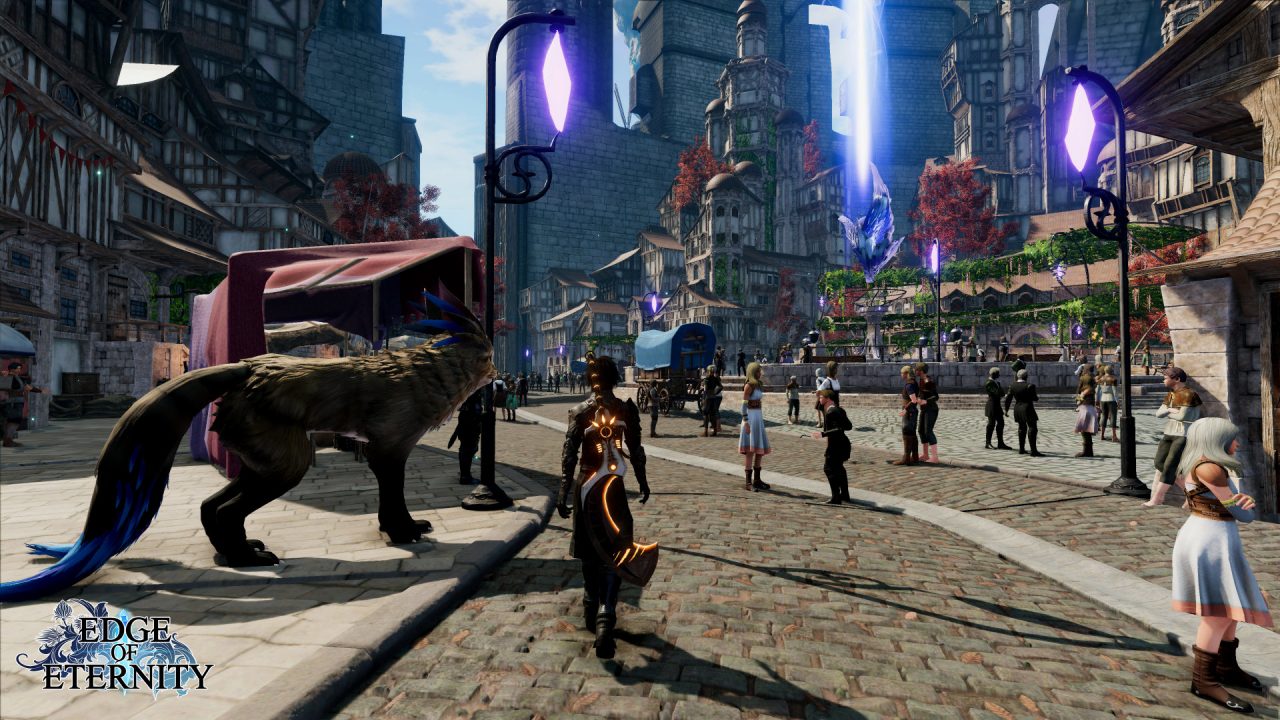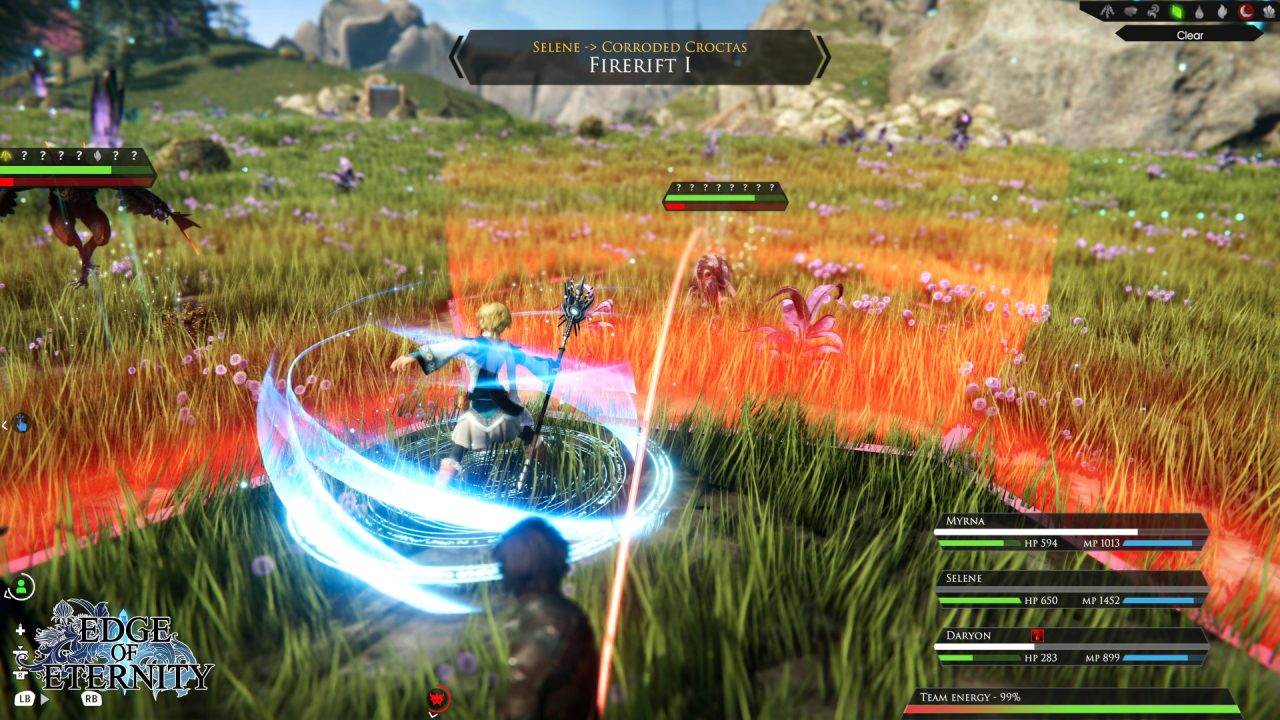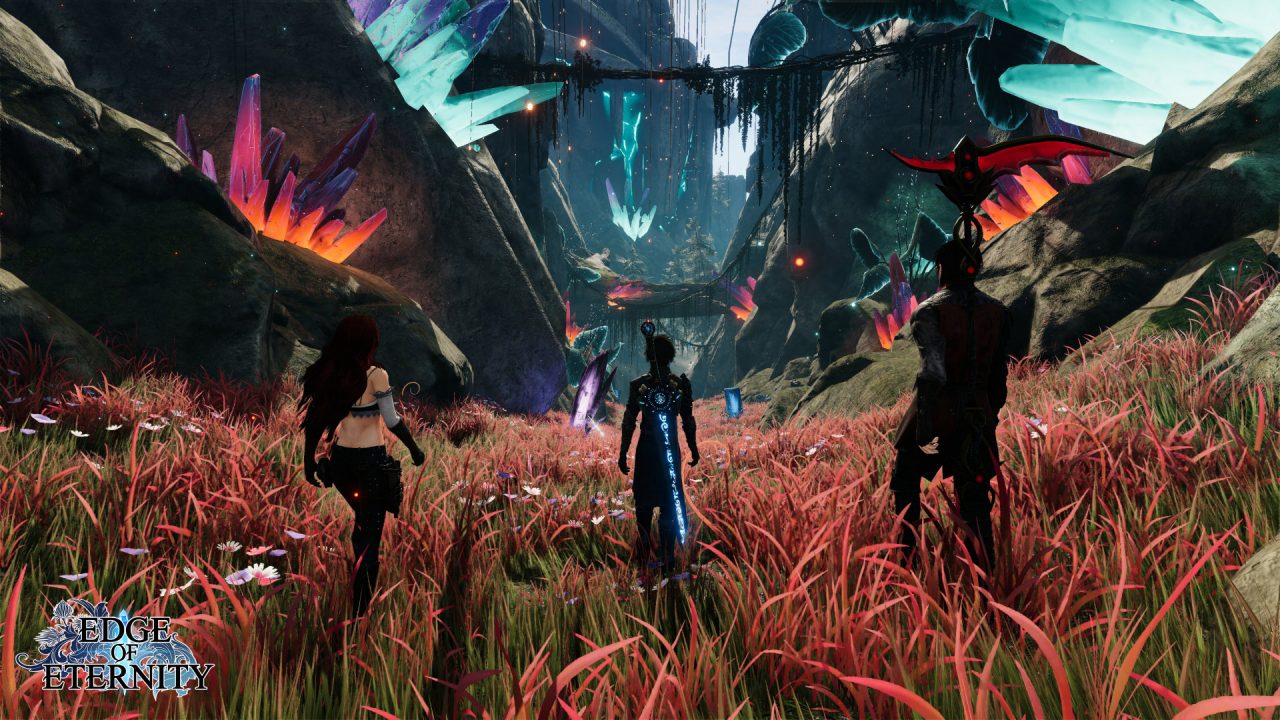Make no mistake, Edge of Eternity is an ambitious game. Its large scale and highly detailed graphics are made even more impressive by the fact that French developer Midgar Studio is a small independent studio lacking the larger budget and resources of big name developers. The Kickstarter-funded homage to classic JRPGs they managed to craft is quite detailed with a wealth of content to peruse, albeit with a few rough patches and a slower story pace than some might appreciate.
Edge of Eternity tells the tale of a world beset by war on two fronts. Heryon is currently facing off against the Archelites, a technologically superior spacefaring people causing massive destruction in their attempts to invade. Meanwhile, a plague called the Corrosion which gradually and painfully turns those who catch it into nightmarish monsters assails the world. A young soldier named Daryon receives word that his mother has caught the Corrosion. His day goes from bad to worse when the Archelites launch a sudden assault on the troops. Following a series of tragedies, Daryon deserts from the army and returns home to help his older sister Selene find a cure for the Corrosion. Their quest takes them across the entire continent, ultimately leading the siblings and their allies to take on a threat of divine proportions.
Many of the areas in Edge of Eternity are quite massive, with numerous treasure chests to uncover as well as resources that can be gathered for crafting purposes. Even after you’ve acquired your speedy two-tailed feline Nekaroo mount, it can take quite a while to traverse these vast expanses (thankfully, there’s helpful fast travel between save points you’ve already been to). The sheer scope of the game’s areas is impressive, and there is so much to uncover in any given location that you can get distracted from the main quest for long stretches of time.

Certain NPCs will dole out side quests, and Hunting Boards also offer optional objectives to peruse. Hunting Board assignments are of the “Go kill this many of this specific type of monster for a reward” variety, while NPC side quests often have you collecting resources and items while delving more into the lore of the game. Notable ones include Daryon helping a flirty grandma who is knowledgeable about food, a surprisingly emotional quest to restore the shrine of a sea goddess who is fading from worship, and helping a soldier with getting toys and books to refugee children currently quarantined due to fear of the Corrosion. The amount of content to be found throughout the lands of Edge of Eternity is impressive and can easily divert hours of playtime if you try to follow every thread you uncover.
As is typical of the genre, party members equip armor and weapons to their person. Armor can be either crafted after acquiring the recipes for it, or they can be bought at merchants. Weapons are often acquired in chests, as quest rewards, or through crafting recipes, with the higher-tiered craftable weapons often being the most powerful. Characters level up as you participate in battles or finish up quests, and there’s a separate leveling system for equipped weapons, too. As a weapon levels up, similar to a party member, its stats will strengthen, and you’ll be able to equip more crystals onto it.
Crystals are special items that help bolster stats once equipped to a weapon and may even provide a unique battle ability or spell. You can fuse crystals together to create more powerful variations, and the crystals you find out in the field grow in strength as you advance throughout the story. Maxing out a weapon’s level and equipping as many high-powered crystals to it as possible can make for some truly impressive character builds. There are numerous branching skill tree paths for crystal equipping as well, allowing you to mold characters as you see fit.
Battles are where Edge of Eternity truly shines. The game uses a variation of the Active Time Battle System, with the party and enemies squaring off on a gridded combat field. These grids are called nexuses, though those familiar with the combat found in Wild ARMs 4 and Wild ARMs 5 might call them “hexes” from time to time. The hex battle system in those two games was something I always regarded fondly, and I was thrilled to be reminded of it when I first started playing Edge of Eternity! Party members and enemies move from nexus to nexus, attacking when they’re within range with their weapons or spells. Some abilities target entire nexuses and damage anyone within that area, while others target only individual characters. Often, special abilities take time to cast for both your party and enemies, so you can try to better position your characters outside damage radiuses or focus your attacks on the offending enemy to counter their intended assault. The nexuses provide a strategic layer to battles, and it’s interesting to figure out how to best utilize them during combat.

Sometimes there are weapons on nexuses that you can interact with and set to target enemies, or there will be an object that can either be detrimental to those standing next to it or boost stats instead. Learning the “lay of the land” is another surprisingly strategic component to combat. Party members are allowed to bring equipped consumable items into combat with them as well. Daryon can equip three battle items to his person while everyone else can bring two. Because of this limitation, you have to choose what you want to bring into battle wisely. I tended to stock up on healing and revival items myself, with Selene reserving space in her limited inventory for ethers to restore her MP since she was flinging so many healing and offensive spells around. You’ve a limited number of times you can even use items in battle, though fortunately the game automatically restocks them at a fight’s end, so choosing when and how to do so is another element of strategy. The battle system is quite versatile and robust, and while I found that fights could take much longer in Edge of Eternity when considering positioning and the like, I never found myself growing bored. This is especially true in boss battles or when you have to fight incoming “wave” skirmishes against numerous groups of foes. There are even puzzles that utilize the nexus grid to great effect.
While the gameplay is quite polished and easy to get the hang of, the characters and plot pacing of Edge of Eternity leave something to be desired, especially before reaching the later stages of the game. The title has all the makings of a grandiose, epic tale but it struggles to come together until closer to the end. Humor, when used, was often very hit-or-miss, and the story certainly hinted at deeper plot points but barely scratched the surface. For instance: the war with the Archelites doesn’t get as much attention as I would’ve liked, especially since the later snippets we see of it are rather intriguing; Selene’s actual goals regarding the Sanctorium are only ever glossed over without any real resolution; for a sky pirate, Fallon has a noticeable lack of any type of air vehicle; we only get hintings of what the Imperator was doing; etc. Maybe this was partially done because the game ends on a clear “there is more to the story” note, but since it takes a while to even hit its narrative stride it is more than a bit disappointing. The glacially slow pace doesn’t do the plot any favors at the beginning parts of the game. Edge of Eternity’s story does eventually develop in more interesting ways later on, but it’s such a gradual process that even the most patient of players will probably struggle with it.
The cast of characters aren’t the most original out there for those familiar with JRPGs, but many of them aren’t bad examples of their archetypes either. I was pleasantly surprised by the later reveals and developments Selene showcased, and the complicated relationship she had with her mother was a strong plot point. Daryon could grate on my nerves, but his attitude made sense given what happens to him and the situations he gets thrown into. At first, I wasn’t quite sure what to make of Sil, a comrade of Daryon’s, but the final scenes involving her were monumentally touching and heartfelt. Daryon and Selene’s mother had an incredibly heroic moment later in the game, and the mysterious fortune teller Myrna kept me speculating about what was really going on in certain aspects of the narrative throughout her all-too brief appearances. My personal favorite character though, and a general highlight of Edge of Eternity, would have to be the chaotic-minded, self-loathing practical jokester Ysoris, who plays a vital role once he is introduced. He steals pretty much every scene he’s in, and I adored how he gets “adopted” by Selene and Daryon. Even his eventual development of romantic feelings towards a certain other character made a lot of sense given his storyline and had me not-so-secretly cheering for him throughout my playthrough. He is awesome, and was definitely deserving of more screen time!
Unfortunately, other characters just fall a bit short. I honestly didn’t think much of Fallon, one of the least explored party members in the plot, beyond that she has decent battle skills. And, while Theia was quite intriguing given her initial role and her reactions to her later predicament, I felt as if they barely scratched the surface with her. These two characters even lacked moments when restoring team energy at the inns and activating scenes with the party members that helped provide further insight to them. While I could see what they were trying to do with their characters, it’s a shame it never gets explored satisfactorily enough.

Graphically, Edge of Eternity is an impressive game in terms of far-away, open world vistas. In still screens, the character models are incredible to behold. But there’s an odd “jaggedness” when the game is in motion and during closeups of characters in scenes, making the body language and expressions often feel “off.” There is a roughness in terms of moving between cutscenes as well, and load times can be quite long if the story jumps from one point to the next. The faraway camera angles sometimes make it difficult to discern what’s happening during combat, and there are instances where even rotating the camera does nothing to alleviate that issue. There was even an instance on my PS5 playthrough where a new cutscene refused to load at all and froze the game, making me restart the entire sequence to get to it again. The artwork used for the game is quite gorgeous and I loved how important characters get expressive headshot art to match their text boxes; however, there is definitely a visual discrepancy in how characters look in the art versus the game graphics that can be quite jarring.
The English language voice acting is quite hit-or-miss as well, though I did feel many of the actors emote better towards the ending. It wasn’t the worst voice acting that I’ve heard for a game, but it wasn’t the best, either. The script itself was localized well, though I did have the odd line of French still pop up once or twice and sometimes what was being spoken didn’t exactly match the subtitles for a given scene. The game does helpfully provide subtitles even for scenes where text boxes aren’t used; however, there were occasionally moments where the name of the character speaking a line was incorrect. Still, I felt like the story was told in a concise fashion and it was easy enough to follow who was saying what. The game’s soundtrack was quite enjoyable to listen to as well, with a lovely orchestral feel to further help convey emotions running through certain scenes or fights. Both composers, Yasunori Mitsuda and Cedric Menendez, did an amazing job; the soundtrack was definitely a highlight!
There’s no denying that Edge of Eternity certainly has a rough quality about it, and I could easily see people viewing its slow beginning as being too much of an obstacle to continue with it. But its robust, tactical-minded nexus battle system, wealth of content, and the eventual pick up of its story gradually warmed me to it. This was clearly a labor of love by the developers, even if it isn’t a perfect product. I enjoyed Edge of Eternity enough that I can only hope that there will be some kind of continuation to Daryon and Selene’s tale in the future… With plenty of Ysoris, of course!


